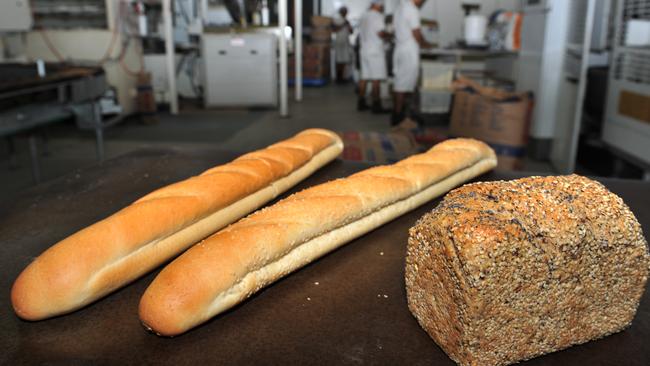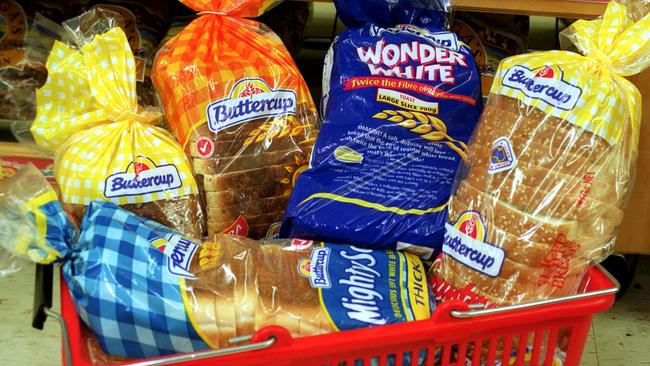Baffled by bread. Which one is best for you?
THERE are dozens of breads to choose from now. So which is best? Our nutritionist reveals once and for all.

IT USED to be simple – you had a choice between white or brown bread.
Now there are dozens to choose from thanks to popular health trends like grain-free and gluten-free diets.
To help you wade through the jargon, news.com.au’s new resident nutritionist Kathleen Alleaume shares her tips for buying the healthiest loaf.
White
Made from wheat that’s milled to remove the outer layers of the grain, resulting in a refined white flour with around 30-50 per cent less fibre compared to wholemeal or grainy varieties. It’s generally high GI meaning the carbs are quickly absorbed sending blood sugar levels to soar — not good news for the waistline and reducing the risk of type 2 diabetes. Kids won’t budge? Not all white breads are created equal. White bread that is labelled hi-fibre and low GI is a good place to start. These types of white bread have had nutrients added such as hi-maize — a type of starch that takes longer to be broken down making it a healthier alternative to regular white bread.
Wholemeal
Not to be confused with the term ‘wholegrain’. Wholemeal is ground wholegrains milled to a finer texture with most of the fibre still intact. However the GI is often still high because some wholemeal breads contain a mixture of refined white flour which creates a longer-lasting flour but doesn’t provide the same nutritional balance. Read the ingredients list to find out.

Wholegrain
Wholegrain is all parts of the nutrient-rich grains and generally have a lower GI for slow digestion and satiety (feeling full). Common wholegrains used in bread include whole wheat, oats and rye. Regular consumption of wholegrain foods is linked to a reduction of several chronic health conditions, such as obesity, heart disease, diabetes and cancer, especially colon cancer. Whole wheat, as the name suggests, is just the whole wheat grain. Multigrain, though, is a different story. Breads with the terms multigrain don’t always mean they use wholegrain in their formula. When choosing multigrain, look for the word ‘kibbled’ which means (broken) grains of wheat, barley, oats or rye.
Lower carb
Although these breads are made with less flour and more seeds they are not low in carbohydrates. They still contain about 20g per sandwich (down from 35g) and are higher in fat (and so kilojoules) thanks to the seeds, so don’t be tricked into thinking you can eat more.
Gluten free
While the availability of gluten-free bread is a wonderful development, especially for people allergic to gluten (a protein component found in wheat, barley, rye and oats), this doesn’t mean they have a better nutritional profile than regular bread. Most gluten-free breads are made from purified or refined starches such as maize starch, white rice flour, potato flour and tapioca starch which are low in vitamins and fibre, so choose varieties with lots of visible seeds and grains for a fibre and antioxidant boost.

Paleo
These breads dish up a combination of gluten free grains, seeds and plant proteins (e.g. pea protein and almond meal). They are extremely low in carbohydrates (2 slices = 3g) and have almost double the protein compared to wholemeal varieties. If you’re very active, this bread may not be the best choice since carbs and fats are the body’s main energy source.
Rye
Rye contains less gluten than wheat flour which makes rye bread significantly denser. Light rye, made from rye and wheat flours, comes in halfway between white and wholemeal for health, but wholegrain rye, with added grains boasts more fibre and vitamins.
Shopper’s Guide
• Read the label. Choose breads made with wholemeal wheat flour as the base, not just wheat flour (ie. white flour), which means all the good dietary fibre has been removed.
• More fibre. Opt for greater than 5 g per serve since this can potentially assist healthy cholesterol levels and weight management.
• Less salt. Choose varieties with less than 350 mg per serve to promote optimal blood pressure levels and healthy arteries.
• Size matters. Unless there are added healthy fats, such as nuts and seeds, a slice of bread should contain no more than around 100 calories (420 kilojoules). Choosing a wider or larger loaf means unnecessarily adding to your calorie count.

So, which is best?
The following are Kathleen’s picks for the best of a wide range of breads on the market as they are low in sodium but provide the necessary fibre and protein for a healthy diet.
• Pure Bread Chia Seed
• Bill’s Organic 100% wholemeal sourdough
• Burgen Traditional Rye
• Helga’s Lower Carb Sunflower & Golden Linseed
• Protein Co Paleo Bread
• Wonder White Plus Hi Fibre
Kathleen Alleaume is an exercise physiologist and nutritionist, and founder of The Right Balance www.therightbalance.com.au





